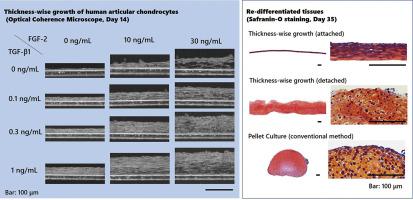Regenerative Therapy ( IF 3.4 ) Pub Date : 2020-01-17 , DOI: 10.1016/j.reth.2019.12.001 Tetsutaro Kikuchi 1 , Tatsuya Shimizu 1

|
Introduction
Cutting the cost of manufacturing is important for extending the use of tissue-engineered therapeutic products. The present study aimed to develop a simple method for fabrication of cartilaginous tissues for regenerative therapy, utilizing the phenomenon where human articular chondrocytes grow thickness-wise and spontaneously form three-dimensionally thick tissues.
Methods
Normal human articular chondrocytes (NHACs) were cultured with varying concentrations of transforming growth factor beta 1 (TGF-β1) and/or fibroblast growth factor-2 (FGF-2) to optimize the culture condition for thickness-wise growth of chondrocytes. Next, the tissues grown in the optimal condition were subjected to re-differentiation culture in attached and detached states to assess differentiation capacity by evaluating secreted factors, histological analysis, and a gene expression assay.
Results
NHACs grew thickness-wise efficiently in the presence of 1 ng/mL TGF-β1 and 10 ng/mL FGF-2. After two weeks of culture, NHACs grew with 11-fold higher thickness and 16-fold higher cell number compared to cells which were neither treated with TGF-β1 nor with FGF-2. These thickness-wise-grown chondrocytes could be re-differentiated by a differentiation medium according to the increase in melanoma inhibitory activity (MIA) and positive safranin-O staining. Interestingly, the cartilaginous gene expression was considerably different between the attached and detached conditions even in the same culture medium, indicating the necessity of detachment and shrinkage to achieve further differentiation.
Conclusions
Spontaneous thickness-wise growth might provide a simple tissue-engineering method for manufacturing cartilaginous 3D tissues.
中文翻译:

人类关节软骨细胞的厚度方向生长技术来制造三维软骨移植物。
介绍
降低制造成本对于扩大组织工程治疗产品的使用非常重要。本研究旨在开发一种简单的方法来制造用于再生治疗的软骨组织,利用人类关节软骨细胞厚度方向生长并自发形成三维厚组织的现象。
方法
将正常人关节软骨细胞 (NHAC) 与不同浓度的转化生长因子 β 1 (TGF-β1) 和/或成纤维细胞生长因子 2 (FGF-2) 一起培养,以优化软骨细胞厚度方向生长的培养条件。接下来,将在最佳条件下生长的组织在附着和分离状态下进行再分化培养,以通过评估分泌因子、组织学分析和基因表达测定来评估分化能力。
结果
在 1 ng/mL TGF-β1 和 10 ng/mL FGF-2 存在的情况下,NHAC 在厚度方向上有效生长。培养两周后,与未用 TGF-β1 或 FGF-2 处理的细胞相比,NHAC 的生长厚度增加了 11 倍,细胞数量增加了 16 倍。这些厚度方向生长的软骨细胞可以根据黑色素瘤抑制活性(MIA)的增加和阳性番红-O染色通过分化培养基重新分化。有趣的是,即使在相同的培养基中,附着和分离条件下的软骨基因表达也有很大差异,表明分离和收缩以实现进一步分化的必要性。
结论
自发厚度生长可能为制造软骨 3D 组织提供一种简单的组织工程方法。











































 京公网安备 11010802027423号
京公网安备 11010802027423号